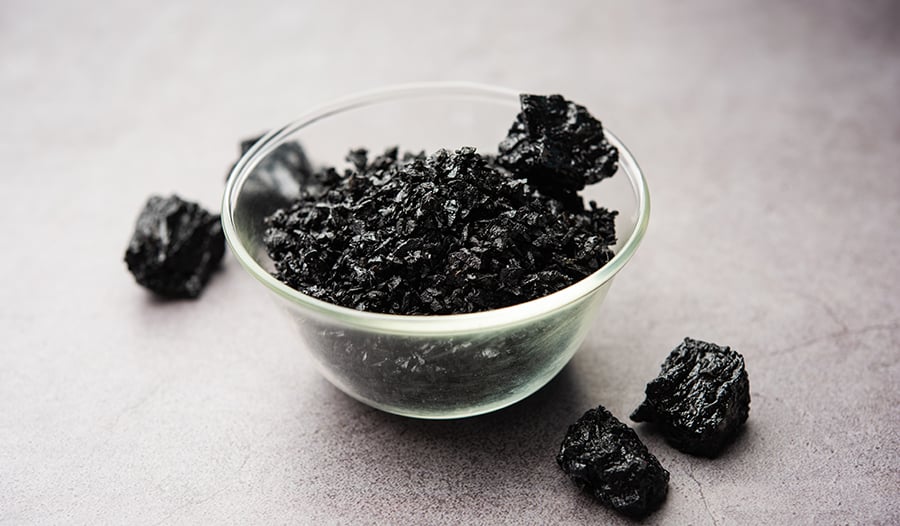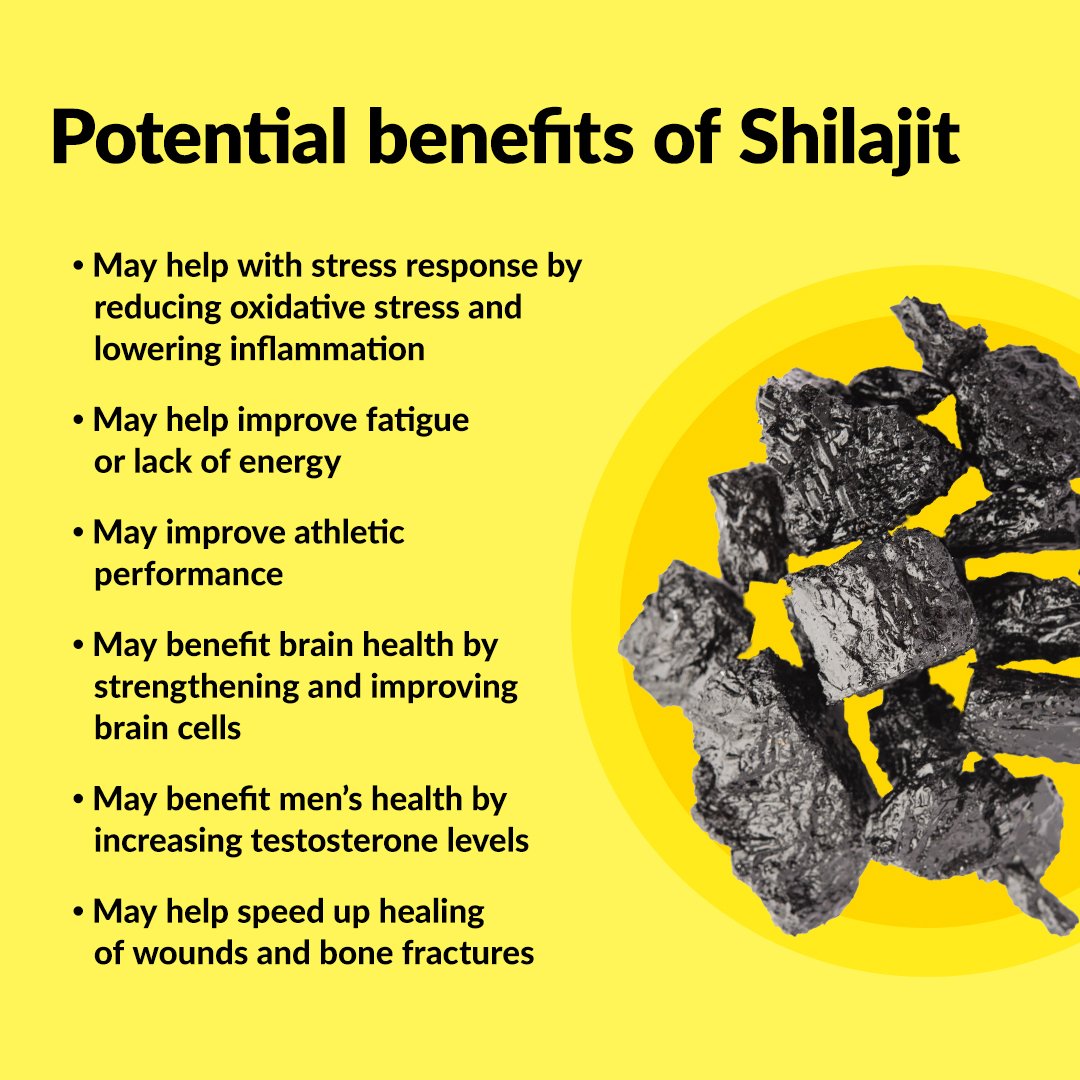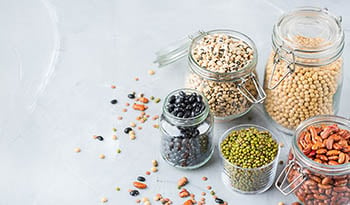Shilajit: A Powerful Antioxidant With Stress Relief Benefits + More
DISCLAIMER:This blog does not intend to provide diagnosis...
- In this article:
- What Is Shilajit?
- Shilajit Nutritional Content
- How Has Shilajit Traditionally Been Used?
- 1. Shilajit May Benefit the Stress Response
- 2. Shilajit May Help Improve Fatigue
- 3. Shilajit May Help Improve Athletic Performance
- 4. Shilajit May Benefit Brain Health
- 5. Shilajit May Benefit Men’s Health
- 6. Shilajit May Help Improve Wound Healing
- Takeaway

Shilajit is a mysterious substance used for thousands of years in ancient cultural medicine. While this medicine of the mountains may be surrounded in a bit of mystery, modern research is beginning to shine a light on the many potential health benefits of this incredible substance.
From acting as an antioxidant to supporting men's health, shilajit may be a modern medicine of the mountains.
What Is Shilajit?
Shilajit is a sticky gum-type substance that ranges in color from a pale brown to a dark brownish black. It is primarily exuded from the rocks of a variety of mountain ranges in India, Russia, Pakistan, and China throughout May through July. Shilajit is most often sourced from the Himalayan and Hindu Kush mountain ranges.
Shilajit is a mix of both plant and mineral material. Studies suggest that it is formed when organic plant material is compressed between heavy rocks. The formation of this incredible substance usually occurs on steep, sunny rock walls at high altitudes between 1,000 and 5000 meters above sea level. Studies have also found that shilajit is more likely to form in rocky, porous areas that are naturally rich in organic carbon.
The word shilajit is a Sanskrit word that means “conqueror or winner of mountains and destroyer of weakness.” The name alludes to not only the pervasive nature of shilajit on sheer rock walls but also to its purported health benefits.
Shilajit Nutritional Content
Used as a traditional healing substance for centuries in Ayurvedic medicine, shilajit may be a natural wonder. This may be because shilajit is filled with minerals like iron, magnesium, and zinc.
Shilajit is also rich in fulvic acid, which makes up 60-80% of the total composition of the substance. Fulvic acid is a substance that is thought to be formed as the by-product of the breakdown of organic matter, like plant life, by bacteria and fungi. Traditional medical practices in India indicate that the fulvic acid in shilajit may help to improve a wide range of conditions.
How Has Shilajit Traditionally Been Used?
In Ayurveda, the traditional medicine of many Indian cultures, shilajit is used almost as a panacea for all types of conditions and ailments. Some of these conditions include digestive disorders, diabetes, urinary tract conditions, and immune support.
While traditional Ayurvedic medicine celebrates shilajit for its potential diverse health benefits, modern research indicates that this substance may indeed have some extraordinary properties.
Some of the incredible properties that shilajit may possess include benefitting the stress response, improving fatigue, performance enhancement, and helping the detoxification pathways of the body.
Below are 6 potential benefits of shilajit.

1. Shilajit May Benefit the Stress Response
Stress is an all too common experience for the vast majority of individuals. Chronic or long-term stress has been linked to a whole host of health issues ranging from mental health disorders to cardiovascular disease. Studies even link chronic stress to a lowered immune response, increased oxidative stress, and higher amounts of inflammation.
Shilajit may help to reduce oxidative stress and lower inflammation in the body. One study double-blind randomized placebo-controlled study focused on shilajit supplementation in women who had undergone menopause and suffered from osteopenia. Osteopenia is low bone mineral density that may contribute to weak bones.
The women in the study were aged between 45-65 years of age and were separated into groups that either received shilajit supplementation or a placebo daily for 48 weeks. The study found that the groups who supplemented with shilajit had lowered amounts of inflammation and oxidative, less bone loss, and higher amounts of glutathione in their bloodstream.
Glutathione is one of the most important antioxidants made by the body. Animal studies also suggest that shilajit may act as a powerful antioxidant by increasing the levels of other body-made antioxidants, like catalase.
It should be noted that in another animal study, shilajit helped to increase oxidative stress. This was thought to, be because shilajit acts as an immune system regulator, not just an immune system stimulator.
2. Shilajit May Help Improve Fatigue
Fatigue is defined as a sense of tiredness or weariness and a general lack of energy. While fatigue may be short-term, it can become chronic, affecting long-term health and wellness.
Some studies suggest that chronic or long-term fatigue may affect up to 10% of the adult population worldwide. It is also estimated that 1% of the world’s population struggles with chronic fatigue syndrome.
Research indicates that shilajit may be helpful for fatigue. One animal study involving a rat model of chronic fatigue syndrome (CFS) found that shilajit supplementation for 3 weeks helped. The study also found that supplementing with shilajit helped reduce anxiety symptoms that may be associated with CFS.
3. Shilajit May Help Improve Athletic Performance
Many active individuals may hit a wall when training due to performance fatigue. Performance fatigue is the decline in output over some time.
Studies suggest that shilajit may help to improve performance fatigue. One study involving 63 active young men between the ages of 21 and 23 studied the effects of a shilajit supplement on fatigue that occurred during a workout session and diminished strength. Participants were separated into groups that received shilajit supplementation and placebo groups. After 8 weeks, the group that received shilajit supplementation saw a decrease in performance fatigue compared to placebo.
4. Shilajit May Benefit Brain Health
As more research is being done on this fascinating substance, it seems that shilajit may benefit brain health. For example, studies suggest that the fulvic acid in shilajit may help benefit Alzheimer’s disease.
Alzheimer’s disease is a progressive condition that causes a loss of memory and a decline in cognition. Research indicates that it is caused, in part, by the gathering together of certain proteins that disturb and prevent brain cell communication.
Studies suggest that fulvic acid may help to prevent the gathering together of these proteins, which could benefit Alzheimer’s disease. Research has also found that shilajit may help to strengthen and improve brain cells resulting in better brain cell communication. Animal studies involving shilajit and ashwagandha extract have found an increase in cognition as well as better memory formation.
5. Shilajit May Benefit Men’s Health
Testosterone is a primarily male hormone that is considered to be responsible for a wide range of functions in the male body. These functions include increasing muscle mass, maintaining muscle strength, producing sperm, and controlling the sex drive.
With age, the body naturally begins to produce less testosterone. Studies suggest that males in their 30s may begin to experience a decline in testosterone levels by 2-3% each year.
Low testosterone levels have been linked to obesity, low muscle mass, erectile dysfunction, and even depression.
Research indicates that shilajit may help to increase testosterone levels. One randomized, double-blind placebo-controlled study focused on healthy male participants between the ages of 45-55 years old.
The study follows the participants for 90 days to see how shilajit supplementation would affect testosterone levels. The study found that the group that received shilajit supplementation had a significant increase in testosterone levels as well as dehydroepiandrosterone, or DHEA, levels.
DHEA is the hormone that the body uses to create testosterone. Studies suggest that taking DHEA can increase the usable or bioavailable testosterone levels in the body.
6. Shilajit May Help Improve Wound Healing
Healing wounds safely and effectively is one of the many marvels of the human body. A quick and sanitary healing process is necessary to prevent the loss of blood as well as any infections.
For some individuals who suffer from diseases like diabetes, the wound healing process may be impaired. This impairment may lead to an increase in the risk of infections.
Research suggests that shilajit may help to speed up the wound healing process. One test-tube study found that shilajit was able to increase the speed of the wound-healing process. The study also found that this incredible substance was able to reduce the inflammation that was associated with the injury.
Another randomized, double-blind, placebo-controlled study focused on the effects of shilajit in healing bone fractures. The study followed 160 participants between the ages of 18-60 years old who had been diagnosed with a fractured tibia and involved 3 different hospitals. Participants were placed in either a group that received shilajit supplementation or a placebo for 28 days. The group that received shilajit supplementation was evaluated by X-ray and found to heal completely 24 days faster than the placebo group.
Takeaway
Shilajit is a mix of both mountainous plant and mineral material that has been used for centuries in Ayurvedic medicine. Modern research suggests that this substance may indeed be the “Conqueror of the Mountains and Destroyer of weakness” because of its potential health benefits.
Shilajit may offer a wide range of benefits for the whole body from acting as a powerful antioxidant to supporting cognition and men’s health. Adding shilajit into a strong health routine may benefit overall wellness long into the future.
References:
- Agarwal SP, Khanna R, Karmarkar R, Anwer MK, Khar RK. Shilajit: a review. Phytother Res. 2007;21(5):401-405. doi:10.1002/ptr.2100
- Andrade V, Wong-Guerra M, Cortés N, et al. Scaling the Andean Shilajit: A Novel Neuroprotective Agent for Alzheimer's Disease. Pharmaceuticals (Basel). 2023;16(7):960. Published 2023 Jul 4. doi:10.3390/ph16070960
- Carrasco-Gallardo C, Guzmán L, Maccioni RB. Shilajit: a natural phytocomplex with potential procognitive activity. Int J Alzheimers Dis. 2012;2012:674142. doi:10.1155/2012/674142
- Ding R, Zhao M, Fan J, et al. Mechanisms of generation and exudation of Tibetan medicine Shilajit (Zhaxun). Chin Med. 2020;15:65. Published 2020 Jun 29. doi:10.1186/s13020-020-00343-9
- Keller JL, Housh TJ, Hill EC, Smith CM, Schmidt RJ, Johnson GO. The effects of Shilajit supplementation on fatigue-induced decreases in muscular strength and serum hydroxyproline levels. J Int Soc Sports Nutr. 2019;16(1):3. Published 2019 Feb 6. doi:10.1186/s12970-019-0270-2
- Kim KH, Jung JH, Chung WS, Lee CH, Jang HJ. Ferulic Acid Induces Keratin 6α via Inhibition of Nuclear β-Catenin Accumulation and Activation of Nrf2 in Wound-Induced Inflammation. Biomedicines. 2021;9(5):459. Published 2021 Apr 22. doi:10.3390/biomedicines9050459
- Malekzadeh G, Dashti-Rahmatabadi MH, Zanbagh S, Akhavi Mirab-bashii A. Mumijo attenuates chemically induced inflammatory pain in mice. Altern Ther Health Med. 2015;21(2):42-47.
- Meena H, Pandey HK, Arya MC, Ahmed Z. Shilajit: A panacea for high-altitude problems. Int J Ayurveda Res. 2010;1(1):37-40. doi:10.4103/0974-7788.59942
- Pandit S, Biswas S, Jana U, De RK, Mukhopadhyay SC, Biswas TK. Clinical evaluation of purified Shilajit on testosterone levels in healthy volunteers. Andrologia. 2016;48(5):570-575. doi:10.1111/and.12482
- Pingali U, Nutalapati C. Shilajit extract reduces oxidative stress, inflammation, and bone loss to dose-dependently preserve bone mineral density in postmenopausal women with osteopenia: A randomized, double-blind, placebo-controlled trial. Phytomedicine. 2022;105:154334. doi:10.1016/j.phymed.2022.154334
- Sadeghi SMH, Hosseini Khameneh SM, Khodadoost M, et al. Efficacy of Momiai in Tibia Fracture Repair: A Randomized Double-Blinded Placebo-Controlled Clinical Trial. J Altern Complement Med. 2020;26(6):521-528. doi:10.1089/acm.2019.0453
- Salleh MR. Life event, stress and illness. Malays J Med Sci. 2008;15(4):9-18.
- Schliebs R, Liebmann A, Bhattacharya SK, Kumar A, Ghosal S, Bigl V. Systemic administration of defined extracts from Withania somnifera (Indian Ginseng) and Shilajit differentially affects cholinergic but not glutamatergic and GABAergic markers in rat brain. Neurochem Int. 1997;30(2):181-190. doi:10.1016/s0197-0186(96)00025-3
- Shailesh K. Bhavsar, Aswin M. Thaker, Jitendra K. Malik, Chapter 51 - Shilajit, Editor(s): Ramesh C. Gupta, Nutraceuticals, Academic Press, 2016, Pages 707-716, ISBN 9780128021477, b978-0-12-802147-7.00051-6.https://www.sciencedirect.com/science/article/pii/B9780128021477000516
- Son, C.-G. (2012) ‘Review of the Prevalence of Chronic Fatigue Worldwide’, The Journal of Korean Oriental Medicine, 33(2), pp. 25–33. Available at: https://www.jkom.org/upload/33-2%2003(25-33).pdf.
- Stanworth RD, Jones TH. Testosterone for the aging male; current evidence and recommended practice. Clin Interv Aging. 2008;3(1):25-44. doi:10.2147/cia.s190
- Surapaneni DK, Adapa SR, Preeti K, Teja GR, Veeraragavan M, Krishnamurthy S. Shilajit attenuates behavioral symptoms of chronic fatigue syndrome by modulating the hypothalamic-pituitary-adrenal axis and mitochondrial bioenergetics in rats. J Ethnopharmacol. 2012;143(1):91-99. doi:10.1016/j.jep.2012.06.002
- Swat M, Rybicka I, Gliszczyńska-Świgło A. Characterization of Fulvic Acid Beverages by Mineral Profile and Antioxidant Capacity. Foods. 2019;8(12):605. Published 2019 Nov 22. doi:10.3390/foods8120605
- Winkler J, Ghosh S. Therapeutic Potential of Fulvic Acid in Chronic Inflammatory Diseases and Diabetes. J Diabetes Res. 2018;2018:5391014. Published 2018 Sep 10. doi:10.1155/2018/5391014

 By Dr. Candace Mathers, N.D.
By Dr. Candace Mathers, N.D.


